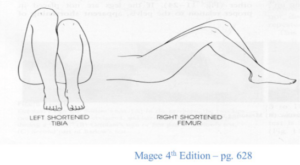Having a short leg is more common than you may think. You may not know that you live with one. A short leg is most commonly identified when you visit a chiropractor for lower back pain. The doctors at Stine Chiropractic Clinic can assess if you have a short leg and provide recommended treatment for it.
What is a short leg?
As you grow, the bones in your legs should grow at about the same rate. However, some individuals may experience bones that stop growing in one leg. This is known as short leg syndrome or leg length discrepancy.
There are three leg bones that grow in length:
- the femur (thigh bone),
- the tibia (shin bone), and
- the fibula (smaller shin bone).
These bones grow as the cartilage cells and bone cells develop in the growth plates in the legs, also known as epiphyseal plates. The cartilage cells are responsible for laying down the framework of long bone growth, which is then covered by bone cells. If the bone cells develop faster than the cartilage cells, however, the bone fuses and stops growth in that leg.
How Does It Develop?
The most common cause of a short leg is developmental. As you grow, one leg grows slower than the other. Once you reach skeletal maturity your growth plates will fuse and long bone growth will no longer be possible. This means your leg length discrepancy will not become any worse.
In rare cases a short leg may be due to a traumatic event. For example, a fracture across the growth plate, especially at an early age, may cause the leg to stop growing.
How do I know if I have a short leg?

Gross leg length discrepancy
Most of the time people don’t know they even have a short leg. The most common symptom of a short leg is lower back pain. A chiropractor can see the un-level pelvis in a x-ray image, keying them into looking for a leg length problem.
The chiropractor will perform an orthopedic test called an Allis test. The patient lays down and brings the knees upward to 90 degrees. With the heels and toes directly parallel to each other the chiropractor can visually see the short leg. If the chiropractor looks from the side and one leg looks longer, then the leg length discrepancy is likely due to a longer femur. If viewed from the bottom (or toe-side) and one leg looks taller than the other, then the short leg is likely due to a long tibia.
Is it normal to have a shorter leg?
It is common to have a short leg. No one is perfect, and the chance you have a minor leg length discrepancy is possible.
How do I fix it?
Short legs are fixed two ways: surgically or conservatively. With a surgical approach you lengthen the short leg or arrest the growth of the other leg. A lot of times you do this prior to skeletal maturity. Consult with a board certified orthopedic chiropractor in Fredericksburg if you are considering surgery for a short leg.
A conservative approach is when you are skeletally mature, usually over the age of 25, and we place a sole insert in your shoe.
If you are experiencing lower back pain, see your chiropractor in Fredericksburg VA who specializes in chiropractic orthopedics. Call 540-898-4100 for a chiropractic consultation or book an appointment.

Visit us at 117 Redwood Drive Fredericksburg, VA 22408.







